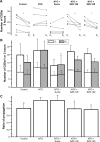Nitroglycerin enhances the propagation of cortical spreading depression: comparative studies with sumatriptan and novel kynurenic acid analogues
- PMID: 28053504
- PMCID: PMC5191838
- DOI: 10.2147/DDDT.S117166
Nitroglycerin enhances the propagation of cortical spreading depression: comparative studies with sumatriptan and novel kynurenic acid analogues
Abstract
Background: The complex pathophysiology of migraine is not yet clearly understood; therefore, experimental models are essential for the investigation of the processes related to migraine headache, which include cortical spreading depression (CSD) and NO donor-induced neurovascular changes. Data on the assessment of drug efficacy in these models are often limited, which prompted us to investigate a novel combined migraine model in which an effective pharmacon could be more easily identified.
Materials and methods: In vivo electrophysiological experiments were performed to investigate the effect of nitroglycerin (NTG) on CSD induced by KCl application. In addition, sumatriptan and newly synthesized neuroactive substances (analogues of the neuromodulator kynurenic acid [KYNA]) were also tested.
Results: The basic parameters of CSDs were unchanged following NTG administration; however, propagation failure was decreased compared to the controls. Sumatriptan decreased the number of CSDs, whereas propagation failure was as minimal as in the NTG group. On the other hand, both of the KYNA analogues restored the ratio of propagation to the control level.
Discussion: The ratio of propagation appeared to be the indicator of the effect of NTG. This is the first study providing direct evidence that NTG influences CSD; furthermore, we observed different effects of sumatriptan and KYNA analogues. Sumatriptan changed the generation of CSDs, whereas the analogues acted on the propagation of the waves. Our experimental design overlaps with a large spectrum of processes present in migraine pathophysiology, and it can be a useful experimental model for drug screening.
Keywords: cortical spreading depression; kynurenic acid analogues; migraine; nitroglycerin; sumatriptan.
Conflict of interest statement
The authors report no conflicts of interest in this work.
Figures



Similar articles
-
Sumatriptan alleviates nitroglycerin-induced mechanical and thermal allodynia in mice.Cephalalgia. 2010 Feb;30(2):170-8. doi: 10.1111/j.1468-2982.2009.01864.x. Cephalalgia. 2010. PMID: 19489890 Free PMC article.
-
Effects of kynurenic acid analogue 1 (KYNA-A1) in nitroglycerin-induced hyperalgesia: Targets and anti-migraine mechanisms.Cephalalgia. 2017 Nov;37(13):1272-1284. doi: 10.1177/0333102416678000. Epub 2016 Nov 16. Cephalalgia. 2017. PMID: 27919017
-
Unexpected effects of peripherally administered kynurenic acid on cortical spreading depression and related blood-brain barrier permeability.Drug Des Devel Ther. 2013 Sep 16;7:981-7. doi: 10.2147/DDDT.S44496. eCollection 2013. Drug Des Devel Ther. 2013. PMID: 24068867 Free PMC article.
-
Effects of glyceryl trinitrate and calcitonin gene-related peptide on BOLD signal and arterial diameter: methodological studies by fMRI and MRA.Dan Med J. 2012 Jul;59(7):B4489. Dan Med J. 2012. PMID: 22759854 Review.
-
Pharmacological synergy: the next frontier on therapeutic advancement for migraine.Headache. 2012 Apr;52(4):636-47. doi: 10.1111/j.1526-4610.2011.02058.x. Epub 2012 Jan 6. Headache. 2012. PMID: 22221151 Review.
Cited by
-
Gut microbiota and migraine.Neurobiol Pain. 2022 Apr 9;11:100090. doi: 10.1016/j.ynpai.2022.100090. eCollection 2022 Jan-Jul. Neurobiol Pain. 2022. PMID: 35464185 Free PMC article.
-
AMPA receptor GluA1 Ser831 phosphorylation is critical for nitroglycerin-induced migraine-like pain.Neuropharmacology. 2018 May 1;133:462-469. doi: 10.1016/j.neuropharm.2018.02.026. Epub 2018 Feb 24. Neuropharmacology. 2018. PMID: 29486167 Free PMC article.
-
Clinical relevance of depressed kynurenine pathway in episodic migraine patients: potential prognostic markers in the peripheral plasma during the interictal period.J Headache Pain. 2021 Jun 25;22(1):60. doi: 10.1186/s10194-021-01239-1. J Headache Pain. 2021. PMID: 34171996 Free PMC article.
-
Quinoline Quest: Kynurenic Acid Strategies for Next-Generation Therapeutics via Rational Drug Design.Pharmaceuticals (Basel). 2025 Apr 22;18(5):607. doi: 10.3390/ph18050607. Pharmaceuticals (Basel). 2025. PMID: 40430428 Free PMC article. Review.
-
Understanding the kynurenine pathway: A narrative review on its impact across chronic pain conditions.Mol Pain. 2024 Jan-Dec;20:17448069241275097. doi: 10.1177/17448069241275097. Mol Pain. 2024. PMID: 39093627 Free PMC article. Review.
References
-
- Lipton RB, Bigal ME. Toward an epidemiology of refractory migraine: current knowledge and issues for future research. Headache. 2008;48(6):791–798. - PubMed
-
- Jansen-Olesen I, Tfelt-Hansen P, Olesen J. Animal migraine models for drug development: status and future perspectives. CNS Drugs. 2013;27(12):1049–1068. - PubMed
-
- Ayata C. Cortical spreading depression triggers migraine attack: pro. Headache. 2010;50(4):725–730. - PubMed
-
- Somjen GG. Aristides Leão’s discovery of cortical spreading depression. J Neurophysiol. 2005;94(1):2–4. - PubMed
-
- Tottene A, Urbani A, Pietrobon D. Role of different voltage-gated Ca2+ channels in cortical spreading depression: specific requirement of P/Q-type Ca2+ channels. Channels (Austin) 2011;5(2):110–114. - PubMed
Publication types
MeSH terms
Substances
LinkOut - more resources
Full Text Sources
Other Literature Sources
Medical

